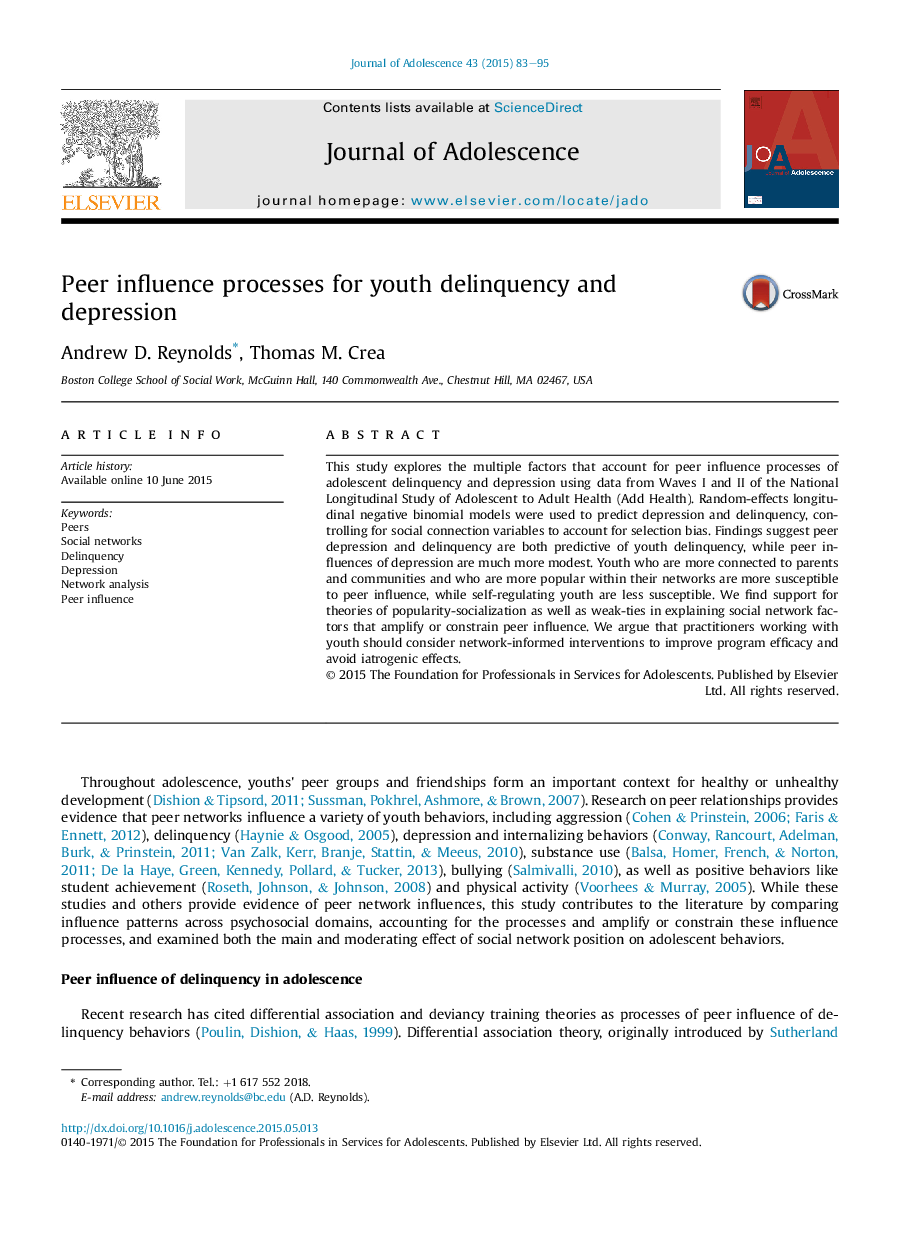Abstract
This study explores the multiple factors that account for peer influence processes of adolescent delinquency and depression using data from Waves I and II of the National Longitudinal Study of Adolescent to Adult Health (Add Health). Random-effects longitudinal negative binomial models were used to predict depression and delinquency, controlling for social connection variables to account for selection bias. Findings suggest peer depression and delinquency are both predictive of youth delinquency, while peer influences of depression are much more modest. Youth who are more connected to parents and communities and who are more popular within their networks are more susceptible to peer influence, while self-regulating youth are less susceptible. We find support for theories of popularity-socialization as well as weak-ties in explaining social network factors that amplify or constrain peer influence. We argue that practitioners working with youth should consider network-informed interventions to improve program efficacy and avoid iatrogenic effects
Conclusions
The results of this study can be summarized by three main points. First, peer influence can cross multiple domains. In our study, we found alter depression to be predictive of individual delinquency. While some other researchers have examined examples of cross-domain influence – particularly with risk behaviors (Prinstein, Boergers, & Spirito, 2001), we argue that more research needs to consider the ways in which peer influence might involve additive and multiplicative models of risk. Second, individual differences make youth more or less susceptible to peer influences. We found that factors associated with attachment and connection – to families, school, religion, or otherwise – represent a youth's “buy-in” to the social environment in which they are placed and thus render them more willing to modify their behaviors to meet the conventions of that environment. However, other factors like self-regulation may provide the skills youth need to navigate participation in behaviors deemed popular or socially accepted. Third, we found that network factors impact youth behaviors in naturally occurring contexts. The behaviors of youth are dependent not only on their own individual characteristics, but depend also on their friendships and where they are positioned within the peer network – and we found this to be true for both delinquency and depression. Thus, those who work with youth must take network factors into account when developing and implementing interventions for youth. Programs that fail to take into account the relationship among youth risk facing iatrogenic or otherwise unintended effects (Dishion & Tipsord, 2011), particularly if the goals, norms, and behaviors of the intervention are in direct opposition to the goals, norms, and behaviors of the youth network receiving the intervention.
We caution against interpreting these findings as reflecting negatively on the youth friendship networks. For every case in which youth may be exposed to negative influences in their friendship network, there may yet be another where that network provides social support, fosters lasting relationships, and promotes positive youth development. Networks are neither good nor bad – they simply exist. Or, as Allen and Antonishak (2008) in their chapter on the positive influence of peers in adolescence, note:
“Blaming peer influence for negative adolescent values and behaviors may ultimately make about as much sense as blaming TV transmission towers for disturbing images that appear on TV. With regards to peer influence, Marshal McLuhan's dictum is emphatically not correct: The medium is not the message. Peer influences transmit values, they don't create them” (Allen & Antonishak, 2008, p. 151).
The implication from this research is not that youth should avoid friendships; rather, it is that interventions with youth should be informed by the social networks in which they are implemented. New research in social network interventions is beginning to document how such interventions might use peer networks as a mechanism for behavioral change, tailoring interventions in order to amplify the treatment (Valente, 2012). One example from substance use prevention research compared three interventions: regular treatment (the school prevention program), a network-inspired treatment, and the control group. The network treatment used friendship nominations from adolescents to identify peer leaders who would lead the intervention. Results indicated that the network-inspired intervention amplified peer influence effects and performed better than the non-network informed treatment-as-usual (Valente et al., 2007).
In short, it not only matters what the intervention is, but rather how, by whom, and under what conditions it is delivered. As the findings of this study suggest that social network position can amplify the peer influence of delinquency and depression behaviors, future research should continue to examine how interventions for youth addressing these behaviors may in turn be amplified or constrained by network influences. Continuing network-based research and developing network-informed interventions that amplify pro-social behaviors and constrain anti-social behaviors may help promote the positive, healthy development of youth.


